- Visibility 52 Views
- Downloads 3 Downloads
- DOI 10.18231/j.ijpca.2024.009
-
CrossMark
- Citation
Evaluation of betulin for hair growth promoting activity in rats
- Author Details:
-
Vinay Vishnudas Sarode *
-
Sadhana P. Gautam
Introduction
Due to the general interest in an individual's body form, hair, cosmetics, and attire, both men and women are under pressure from society to look a certain way.[1] Numerous studies on hair loss demonstrate the significant role that hair plays in social and sexual communication as well as the appearance of the human body.[2]
One of the essential components of the body, hair is an appendage that provides protection and is derived from the ectoderm of the skin. It plays a significant role in the human body's allure.[3]
Alopecia
Alopecia is a generic term that is generally used for hair fall and loss. Hair loss is a natural daily phenomenon, but this shedding of hair cannot be the main cause of hair loss.[4]
Types of Alopecia
Alopecia can be classified by different ways
A) According to their causes alopecia may be classified as follows-
Non-scarring Alopecia: It happens because of genetic issues, getting older, taking medications like contraceptives and anti-cancer chemotherapeutic drugs, applying chemical treatments topically like hair dyes, permanent wave solutions, and straighteners, getting sick, having allergies, or getting infections in the hair follicles.[5]
Scarring Alopecia: It can happen as a result of trauma, which frequently destroys follicles, or burns (accidental or after surgery from cryosurgery or laser surgery).[5]
B) According to factor responsible alopecia may be classified as follows-
Androgenetic Alopecia (AGA)
AGA is a common hereditary thinning of hair induced by androgens in genetically susceptible and this condition is known in men as common baldness and as female pattern baldness in women.
AGA is major type of scalp hair loss that affects 60 70% of the population. It affects
50% of male by the age of 50 years and up to 70% of all males in the later life.
25% of women by the age of 49 years and 41% at the age of 69 years.
It is characterized by the miniaturization of the large, thick pigmented terminal hair with a diameter of > 0.03 mm to small, fine, non-pigmented vellus hair with a diameter of ≤ 0.03 mm. This characteristic of AGA is due to premature entry of the hair follicle into the catagen phase and the delay in the transition from the telogen phase to the anagen phase, resulting in the shortening of the anagen phase. [5]
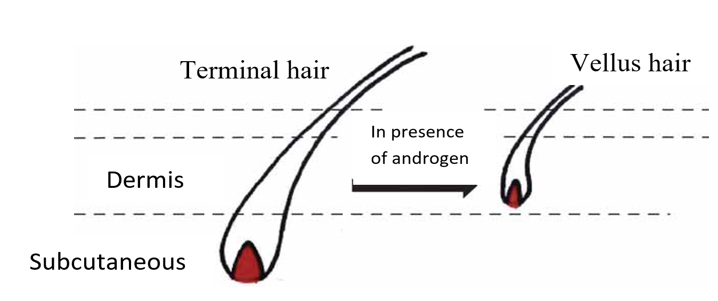
Alopecia Areata: Alopecia areata is characterized by patchy scalp baldness. Most common reasons of alopecia areata are pregnancy, hormone pills, thyroids disorder, and sexually transmitted disease like syphilis, gonorrehea, anemia and arthritis.[6]
Alopecia Universalis: Alopecia universalis is a type of alopecia in which total body hair loss occurs Patients are usually healthy, it occurs due to the thyroid disease and vitiligo and hair loss all over the body.[6]
Factors related to Hair Loss
There are various factors which affects growth of hairs.[7]
|
Factors |
Description |
|
Major physical–emotional stress |
Surgery, severe illness, diet or nutrition changes and emotional stress can cause hair loss. |
|
Chemotherapy |
Parkinson medications, anti-ulcer drugs, anticoagulants, agents for gout, anticonvulsants for epilepsy, antidepressants, beta-blocker drugs, anti-thyroid agents, anti-neoplastics, blood thinners, male hormones. |
|
Smoking |
Tobacco smoke damages the lining of blood vessels, leading to less production of nitric oxide and thus inducing hair loss. |
|
Genetic pre-disposition |
Genetic component to androgenetic hair loss exists (polygenic inheritance) |
|
Cardiovascular |
Diseases high levels of LDL in cardiac patients are converted to 5-alpha reductase enzyme, which produces DHT from testosterone, causing hair loss. |
|
Dihydro- testosterone (DHT) |
Increased level of DHT (the testosterone metabolite) shortens the hair cycle and progressively minimizes scalp follicles and this may be due to the atherosclerotic process blocking the microvasculature that nourishes the hair follicles. |
Drug Profile
Name of Drug: BetulinIUPAC Name: Lup-20(29)-ene-3β,28-diolChemical Formula: C30H50O2
Structure of betulin
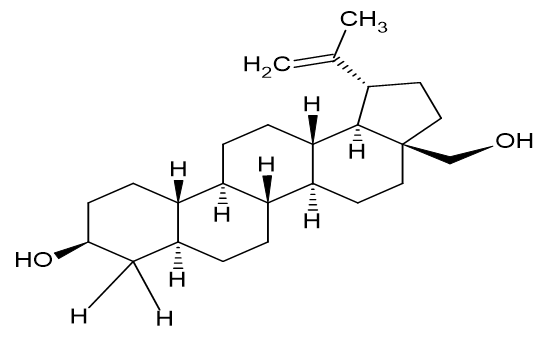
Category of Chemical Constituent: Pentacyclic triterpene alcohol with lupane skeleton
Source: The major source of betulin is outer bark of Birch Trees. A lesser amount can be found in the skin and leaves of birches.[8]
Mechanism of Action: Betulin inhibit the maturation of Sterol Regulatory Element Binding Protein (SREBP) and thus decrease the biosynthesis of cholesterol and fatty acids. It decreases the lipid contents in serum, tissues and increases insulin sensitivity.[9]
Pharmacological Activity: Betulin has shown antimicrobial, anti-bacterial, antiviral, anti-HIV, anti-inflammatory, anti-diabetic, hepatoprotective, gastroprotective, anti-proliferative, anti-hyperlipidaemic, anti-malarial and anti-cancer activities.[10]
Materials and Methods
Procurement of animals & their diet
The Albino rats (Wistar strain) of age 12-16 months, weighing between 200 ± 30g, were procured from the animal house of Institute of Pharmaceutical Education and Research (I.P.E.R.), Wardha. The animals were housed in the polypropylene cage at a temperature of 24º ± 2ºC with the relative humidity of 40-60% and 12 hour light / dark cycle. Animals were fed with balanced diet and water during the complete experimental period. The experimental protocol was approved by the Institutional Animal Ethics Committee of Institute of Pharmaceutical Education and Research, Wardha (Registration Number 535/PO/Re/02/CPCSEA) on dated 01.12.2018 with Protocol No. IAEC/2018-19/02
Preparation of Testosterone (Sustanon 100)
The dose of Testosterone 0.5 mg/kg, by subcutaneous route for 21 days was selected on the basis of literature survey.[11]
Testosterone (Sustanon 100) 100 mg injection was diluted with 200 ml arachis oil, this was able to produce concentration 0.5mg/ml.
The dose of Testosterone (0.5 mg/kg, s.c) was calculated according to the body weight of the animal and was administered for the preparation of alopecia model.
Preparation of 3% Minoxidil Solution
The topical 3% minoxidil solution was selected on the basis of literature survey. [12]
3% Minoxidil solution was prepared by using propylene glycol, alcohol and water in the ratio of 5:3:2 and was applied to the animals topically for 28 days.
Preparation of Betulin
The dose of betulin 10mg/kg, 20mg/kg, 40mg/kg p.o and betulin topical was selected on the basis of literature survey. [13]
The dose of betulin (10mg/kg, 20kg/kg, 40mg/kg) was calculated according to the body weight of the animal and was administered to the rats per orally (p.o) for 28 days.
The betulin topical (3mg/ml) solution was prepared by using olive oil and applied topically for 28 days. The drug solutions for the studies were freshly prepared.
Experimental Design
|
Sr. No. |
Group |
Treatment |
Doses and Routes |
No. of Animals |
|
1 |
Group I (Normal) |
Saline |
Saline solution, p.o. |
6 |
|
2 |
Group II (Control) |
Testosterone |
0.5mg/kg, s.c. |
6 |
|
3 |
Group III (Standard) |
Minoxidil |
Topical |
6 |
|
4 |
Group IV (Test I) |
Betulin |
10mg/kg, p.o. |
6 |
|
5 |
Group V (Test II) |
Betulin |
20mg/kg, p.o. |
6 |
|
6 |
Group VI (Test III) |
Betulin |
40mg/kg, p.o. |
6 |
|
7 |
Group VII (Test IV) |
Betulin |
Topical (3mg/ml) |
6 |
|
8 |
Group VIII (Test + Std.) |
Betulin + Minoxidil |
10mg/kg, p.o. + topical |
6 |
After induction period of 21 days i.e. on 22ndday and after treatment period of 28 days i.e. on 49thday the initial and final weight were taken respectively. Blood was withdrawal by retro-orbital plexus method and biochemical parameters were performed on 22nd and 49th day. 3 mm area of skin of two rats from each group were taken on 22nd day and 49th day. Samples were stored in 10% formalin solution and sent for histopathological studies.
Induction of Alopecia
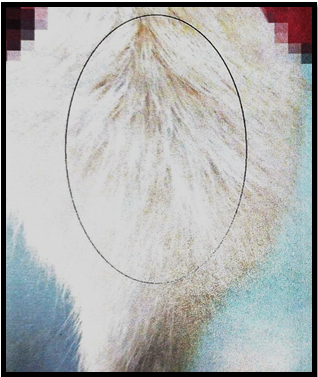
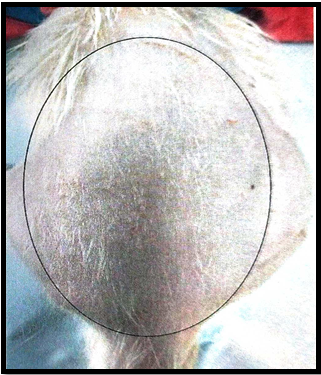
Results
Determination of physiological parameters
Measurement of body weight
The body weight of animals of each group was measured on 1st day i.e. initial weight, on 22nd day after induction of alopecia i.e. intermediate weight and on 49th day after treatment i.e. final weight.
|
Group No. |
Treatment |
Body Weight |
||
|
1st Day |
22nd Day |
49th Day |
||
|
I |
Normal (Saline Solution) |
339.66 ± 19.68 |
340 ± 17.49 |
346.16± 17.34 |
|
II |
Control (Testosterone) |
287.5 ± 8.71 |
354.83 ± 11.18@ |
353.5 ± 9.78@ |
|
III |
Standard (Minoxidil) |
317.5 ± 4.77 |
364.5 ± 6.10@ |
341.33 ± 6.23ns |
|
IV |
Test I (Betulin 10mg/kg,p.o) |
158.66 ± 10.08 |
249.5 ± 5.85@ |
237.83 ± 3.63** |
|
V |
Test II (Betulin (20mg/kg, p.o) |
241.66 ± 6.24 |
293.33 ± 3.87@ |
271 ± 4.10ns |
|
VI |
Test III (Betulin (40mg/kg, p.o) |
212.66 ± 8.28 |
255.16 ± 3.70@ |
236.83 ± 16.80*** |
|
VII |
Test IV (Betulin (Topical) |
213.66 ± 12.86 |
265.33 ± 13.25@ |
240 ± 13.70* |
|
VIII |
Test I + Std. (Betulin + Minoxidil) |
214 ± 11.41 |
267.16 ± 18.12@ |
245.16 ± 16.26ns |
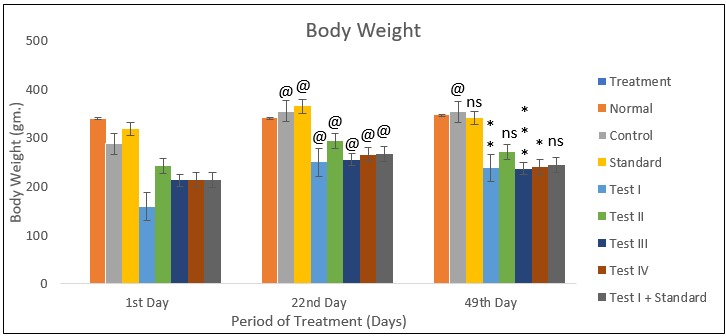
Observation shows that after induction of alopecia with testosterone on 22nd day there was significant increase in body weight of animals of all groups as compared to 1st day of study but there was no significant change in weight of normal group animals was decreased after the treatment with standard drug, various doses of betulin and combination of betulin with standard drug on 49th day as compared to 22nd day.
Estimation of Biochemical Parameters
Cholesterol level
The measurement of cholesterol makes it possible to identify hypercholesterolemia, which is linked to hypertriglyceridemia. Elevated cholesterol levels are linked to an increased risk of vascular accidents and the development of atherosclerosis. The ratio should be taken into account when assessing one's risk of cardiovascular disease.
For determination of cholesterol level the collected blood sample was sent to Amey Pathology Laboratory, Socialist Square, Wardha.
|
Group No. |
Treatment |
Cholesterol Level |
|
|
22nd Day |
49th Day |
||
|
I |
Normal (Saline Solution) |
51.5 ± 2.71 |
54.16 ± 3.36 |
|
II |
Control (Testosterone) |
111.33 ± 3.72@ |
99.66 ± 2.71@ |
|
III |
Standard (Minoxidil) |
112.833 ± 6.81@ |
66.16 ± 3.71* |
|
IV |
Test I (Betulin 10mg/kg,p.o) |
114 ± 5.77@ |
82.83 ± 3.55ns |
|
V |
Test II (Betulin (20mg/kg, p.o) |
115 ± 7.46@ |
73.5 ± 5.07ns |
|
VI |
Test III (Betulin (40mg/kg, p.o) |
126.33 ± 6.82@ |
59.5 ± 4.63*** |
|
VII |
Test IV (Betulin (Topical) |
121.83 ± 10.18@ |
60.16 ± 3.32** |
|
VIII |
Test I + Std. (Betulin + Minoxidil) |
120.33 ± 6.58@ |
78.5 ± 3.59ns |
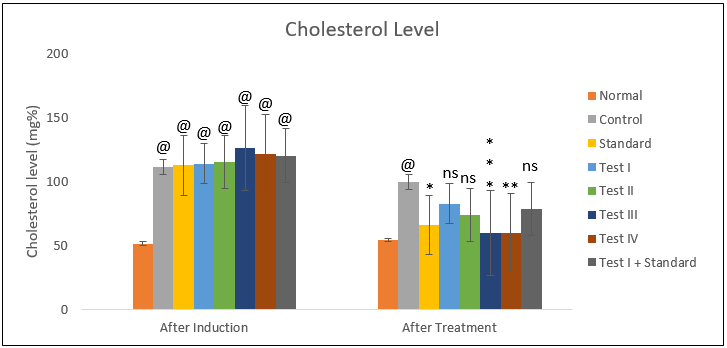
Observation shows that after induction of alopecia with testosterone on 22nd day there was increase in level of cholesterol in blood of animal.
After treatment with standard drug and various doses of Betulin, cholesterol level decreases. Significant decrease observed in animals treated with Betulin 40 mg/kg p.o., Betulin topical and standard drug Minoxidil topical solution where as other group animals treated with betulin 10 mg/kg p.o., betulin 20 mg/kg and combination of test and standard drug does not show significant decrease in cholesterol level in blood of animals. These observations show that Betulin 40 mg/kg p.o. is best effective dose.
Testosterone Level
Elevated testosterone level indicates hyper-androgenism. The collected blood samples by the retro orbital plexus route were sent to Amey Pathology Laboratory, Socialist Square, Wardha. The serum testosterone level was stimulated by Electro chemiluminescence.
|
Group No. |
Treatment |
Testosterone Level |
|
|
22nd Day |
49th Day |
||
|
I |
Normal (Saline Solution) |
280.94 ± 6.40 |
276.59 ± 6.58 |
|
II |
Control (Testosterone) |
900.3 ± 13.71@ |
888.03 ± 10.74@ |
|
III |
Standard (Minoxidil) |
881.3 ± 34.05@ |
368.04 ± 6.66*** |
|
IV |
Test I (Betulin 10mg/kg,p.o) |
890.11 ± 27.20@ |
682.12 ± 12.02ns |
|
V |
Test II (Betulin (20mg/kg, p.o) |
892.76 ± 33.21@ |
589.21 ± 14.75ns |
|
VI |
Test III (Betulin (40mg/kg, p.o) |
901.78 ± 26.90@ |
445.96 ± 12.42* |
|
VII |
Test IV (Betulin (Topical) |
857.26 ± 36.32@ |
377.48 ± 12.26** |
|
VIII |
Test V (Betulin + Minoxidil) |
910.76 ± 17.62@ |
555.56 ± 14.45ns |
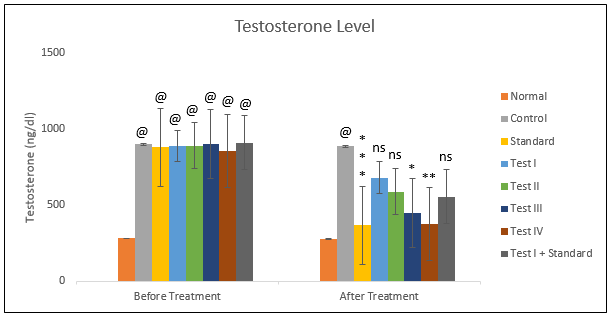
Observation shows that testosterone level increased after induction of alopecia with testosterone on 22nd day but after treatment testosterone level decreased. Treatment with standard drug significantly lowers the testosterone level. Betulin 40mg/kg p.o. and Betulin when applied topically also significantly decreased testosterone level.
Evaluation of Biological Parameters
Skin irritation test
The Betulin (3mg/ml) in Olive Oil was assessed for primary skin irritation test. All group animals were used for the study. Each animal rat was caged individually and food and water given during the test period for 24 hours, prior to the test. The dorsal skin 1cm2 area of animal was cleaned with spirit. Betulin (3mg/ml) solution was topically applied to animals and observed for erythema and edema for 48 hours after application.
Observation found that no erythema and edema occurred in any animal within 48 hours after topical application of Betulin (3mg/ml) solution. It indicated that it is safe for topical use.
Measurement of hair length
Quantitative model for the evaluation of hair growth measurement was performed. Hair was plucked randomly using sterile forceps from the depilated area on 30th day of treatment and the hair length was measured with the help of scale and the results were calculated as mean length ± SEM of 25 hairs.
|
Group No. |
Treatment |
Hair Length (mm) (Mean±SEM) |
|
|
14th Day |
28th Day |
||
|
I |
Normal (Saline Solution) |
19.51±0.57 |
24.12 ± 0.47 |
|
II |
Control (Testosterone) |
14.19±0.28 |
20.52 ± 0.41 |
|
II |
Standard (Minoxidil) |
22.43±0.56 |
30.82 ± 0.48*** |
|
IV |
Test I (Betulin 10mg/kg,p.o) |
18.36±0.42 |
23.41 ± 0.47 |
|
V |
Test II (Betulin (20mg/kg, p.o) |
20.62±0.39 |
25.61 ± 0.63 |
|
VI |
Test III (Betulin (40mg/kg, p.o) |
20.89±0.47 |
26.89 ± 0.60* |
|
VII |
Test IV (Betulin (Topical) |
22.88±0.55 |
28.09 ± 046** |
|
VIII |
Test V (Betulin + Minoxidil) |
15.33±0.48 |
22.89±0.55 |
After treatment, when hair length was measured it found that length of hair increases. Faster hair growth observed in animals treated with standard drug. Aminals treated with topical Betulin also show hair growth with 28.09mm length as compared with other doses of betulin.
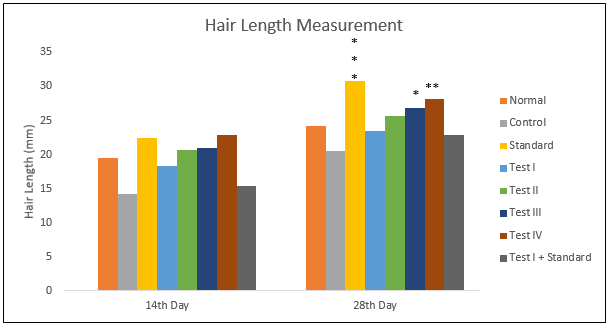
Histological Study
After the treatment with standard drug and various doses of Betulin, on 28th day of treatment, two rats from each group were selected for cutting the section of the skin. Skin biopsies were obtained from the depilated portion of the rats and preserved in 10% formalin solution. The samples were sent to Amey Pathology Laboratory, Socialist Square, Wardha for the further studies.
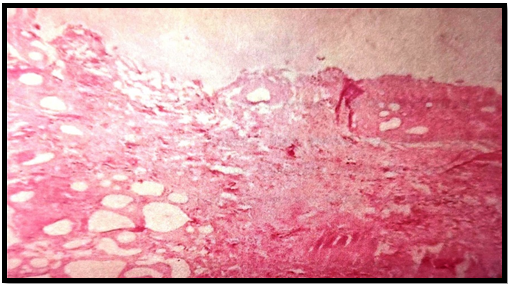
Histopathological section of the normal rat skin shows normal epidermis or dermis layer

Histopathological section of alopecia induced induced skin shows heavy infiltration of lymphocytes, plasma cells, macrophages in deep dermis. Epidermis shows diffuse atrophy and ballooning degerneration. Histological features thus suggested the appearance of Chronic Dermatitis.
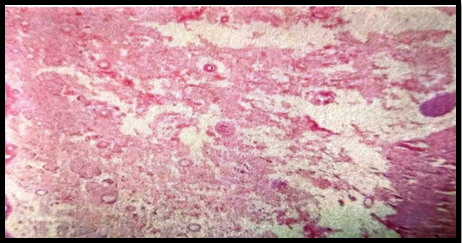
Histopathological section of the standard drug treated skin shows no remarkable changes in epidermis or dermis means Minoxidil repair the changes occur after induction of alopecia. Thus histological features are within normal limits.
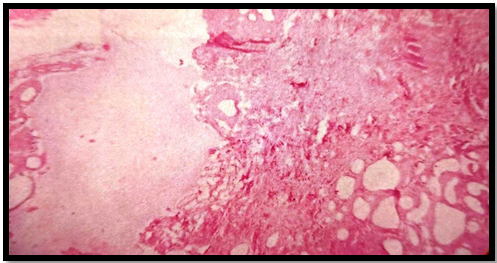
Histological section of the skin treated with Betulin 10mg/kg p.o. shows diffuse degeneration of keratocytes, flattening of epidermis, acantholysis. There is heavy infiltration of lymphocytes in deep dermis. This histological feature indicates drug/chemical induced dermatitis.
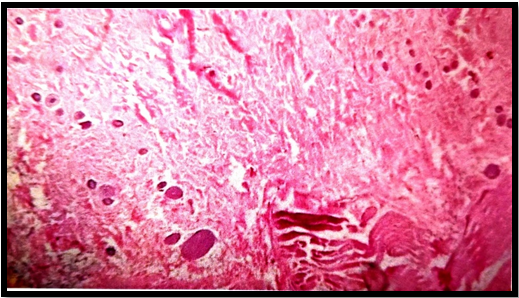
Histopathological section of skin treatment with Betulin 20mg/kg p.o. shows spongiosis, diffuse atrophy of squamous epithelium and ballooning. It also shows degeneration of basal cells of epidermis. Section shows dermal adnexae are normal. These histological feature are indicates that all changes are drug/chemical induced changes.
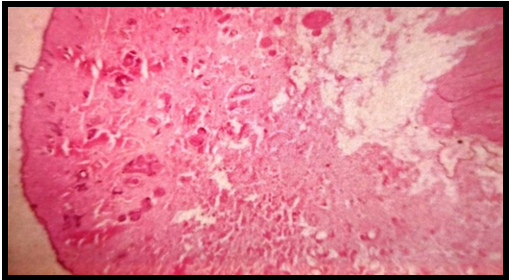
Histopathological section of the skin treated with Betulin 40mg/kg p.o. shows no remarkable changes in epidermis or dermis which may due to restoration of the changes observed during induction of alopecia.
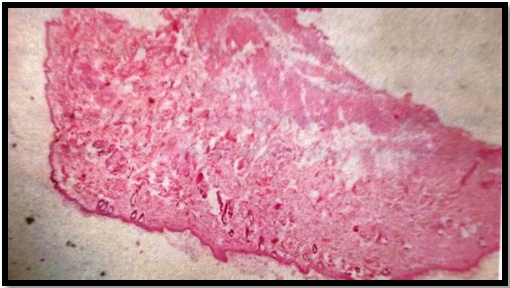
Histopathological section of the skin treated with Betulin Topical shows no remarkable changes in epidermis or dermis. Betulin Topical repair the changes occur after induction of alopecia. Thus histological features are with normal limits.
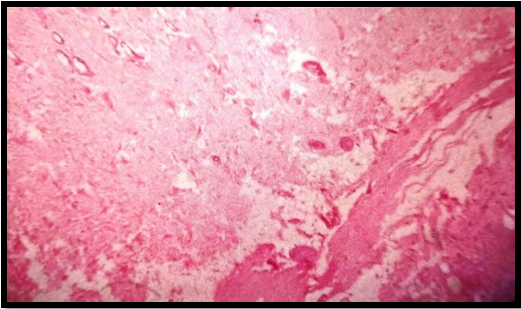
Histopathological section of skin treated with test drug i.e. Betulin 10mg/kg p.o. and Standard drug (Minoxidil) shows epitheloid granulomas, Langhan’s Giant cell, necrosis in deep dermis. Epidermis is histologically unremarkable. Histological feature indicate appearance of Tuberculosis.
Statistical Analysis
Data were analysed using Graph Pad Prism 5 for Windows (version 5.00). Results expressed as Mean ± SEM. Two-way analysis of variance (ANOVA), Bonferroni’s and Tukey’s post-test were used to test the significance of the difference between the variables in various groups. The P values of less than 0.05 were considered to be statistically significant.
Discussion
Hair has been sign of beauty and a contribution to an individual personality. Many factors such as metabolism, hormones, heredity and side effects of anti-neoplastic and immune suppressant drugs are negatively affects the healthy growth of hair and results in hair loss that generally called alopecia. It is common throughout the world.[7]
Androgens like testosterone are mediators of terminal hair growth all through the body. An elevated testosterone level is not the cause of hair loss. Dihydrotestosterone (DHT) (metabolised form of testosterone) is more potent androgen, is responsible for hair loss.[14]
Hair loss results when certain hair follicles on scalp are highly sensitive to DHT. As a result of this sensitivity, hair follicles shrink and eventually disappear. Based on these findings, DHT is held responsible for miniaturization of hair follicles in androgenic alopecia. [15]
There are number of ways by which drug may stimulate hair growth like it may increase the linear growth rate of hair, increase the diameter of the hair fibre, alter the hair cycle, either shortening telogen or prolonging anagen or act through a combination of both effects.
Minoxidil (Topical) is the FDA approved drug used for the treatment of alopecia.
Minoxidil is a vasodilator and potassium channel opener known to prolong the anagen phase and converts vellus hair to terminal hair. Minoxidil solutions causes scalp irritation, headaches, dizzy spells, itchiness, redness, contact dermatitis.
Various researches shows that betulin (Triterpene) exhibit a wide range of activities like antimicrobial activity, anit-inflammatory, antiviral, hepatoprotective and anticancer. Triterpenes now a day’s mostly used for cosmetic applications. Highly pure betulin widely used in the pharmaceutical and cosmetic industries. Betulin and its semisynthetic derivatives have high potential in medicine. [14]
Betulin occurs in a number of plants, especially in many species of birch, where it found in large amount in the outer bark.[8] Triterpenoid like Lupeol, Betulinic acid present in different plants like Birch bark, Careya Arborea, Alangium salvifolium and Alstonia scholaris are used in the hair conditioners and shampoos. They help to reduce hair loss, improve keratin absorption, reduce inflammation and inhibit bacterial growth.[16]
Literature survey shows that Betulin is a triterpenoid also used in the hair conditioners and shampoos since 19th century. Some studies shows that increase in the cholesterol level causes the hair loss and betulin was found to lower the cholesterol level hence it may inhibit the hair loss. By considering the above fact we investigated hair growth promoting activity of betulin on testosterone induced alopecia.
In present study testosterone (0.5 mg/kg) subcutaneously administered for 21 days to rats for induction of alopecia. The fall of hair and appearance of baldness ([Figure 4]) confirmed the induction of alopecia. The alopecia developed by testosterone may be due to the high sensitive of hair follicles toward DHT. As a result of this sensitivity, hair follicles shrink and eventually disappear. It was further confirmed by determination of various parameters.
The body weight of animals significantly increase after induction of alopecia with testosterone on 22nd day ([Table 3] and [Figure 5]). Whereas body weight of animals of all groups except normal group animals was decreased after the treatment with standard drug, various doses of betulin and combination of betulin with standard drug on 49th day. Some studies have suggested that chronic administration of testosterone, increase body weight and body fat in experimental animals. Testosterone might disturb the mechanism that protect against adiposity and hyperphagia and represent the risk factor for excessive body and obesity. [17]
Observation of biochemical parameters shows that cholesterol and testosterone level increased after induction of alopecia ([Table 4] and 5) ([Figure 6], [Figure 7]). Testosterone level increased because it is used as an inducer and cholesterol level increased may be due to testosterone which may increase in microsomal enzyme activity, resulting in increased cholesterol production by the liver.
After treatment with standard drug and various doses of betulin, cholesterol level decreased. Betulin, may decreased the biosynthesis of cholesterol and fatty acid by specially inhibiting the maturation of sterol regulatory element-binding proteins (SREBP).[9]
Minoxidil also decreased the cholesterol and testosterone level but its mechanism of action have still not been comprehensively understood but one of the in-vitro study shows that Minoxidil changes the activity of 5-α-reductase type 2 inhibitor. This anti-androgenic effect of minoxidil, shows by significant down regulation of 5α-R2 gene expression in HaCat cells, may be one of its mechanism of action in alopecia. [18]
For testing the safety of betulin, skin irritancy test was performed on animals. Observation found that no erythema and edema occurred in any animal within 48hours after topical application of Betulin (3mg/ml) solution. It indicated that it is safer for topical use.
For checking the hair growth promoting effect of standard drug Minoxidil and betulin, hair length was measured two times i.e. after 14th and 28th day of treatment. Faster hair growth observed in animals treated with standard drug with hair length 30.82mm. Animals treated with topical topical betulin also show hair growth with 28.09mm as compared with other doses of betulin ([Table 6] and [Figure 8]). The results of betulin indicates that topical application of betulin shows better and fast hair growth than use of oral betulin. Topical betulin shows better effect may be due to more absorption in the skin as it used along with olive oil. Olive oil contains hydrophilic phenols which are rich in antioxidants effect and thus it has benn used as a skin product and hair cosmetic.
For the checking of induction of alopecia, the histopathology study was conducted. Histopathological section of alopecia induced skin shows heavy infiltration of lymphocytes, plasma cells, macrophages in deep dermis. Epidermis shows diffuse atrophy and ballooning degeneration, which results in appearance of Chronic Dermatitis ([Figure 10]). These features indicated the induction of alopecia.
For the checking hair growth effect of betulin, the histopathology study was conducted. Histopathological section of the skin treated with Betulin 40 mg/kg p.o. and skin treated with Betulin Topical shows no remarkable changes in epidermis or dermis which means that betulin restore the changes which observed in alopecia induced skin, may be due to its antioxidant potency.
The histopathology of skin treated with test drug i.e. Betulin 10 mg/kg p.o. and standard drug (Minoxidil) shows epitheloid granulomas, langhan’s giant cells, necrosis in deep dermis. Histologically epidermis is unremarkable. All these histological features indicate appearance of Tuberculosis. The cause of such effect is unknown.
Conclusion
The present study showed that Betulin, a triterpenoid, effective against testosterone induced alopecia. It decreases the level of testosterone and ultimately level of DHT which mainly responsible for the hair loss. Various doses of betulin work against alopecia but topical application show better effect. Topical betulin shows better effect may be due to more absorption in the skin as it used along with olive oil which antioxidants. A histopathological observation also proves these results of betulin.
Source of Funding
None.
Conflict of Interest
None.
References
- S Helfert, P Warschburger. The face of appearance-related social pressure: gender, age and body mass variations in peer and parental pressure during adolescence. . Child Adolescent Psychiatry Mental Health 2013. [Google Scholar]
- R Suraja, G Rejitha, A Jeba, SB Anandarajagopala, K Promwichita. In vivo hair growth activity of Prunus dulcis seeds in rats. Biol Med 2009. [Google Scholar]
- S Anarthe, BJ Reddy, MP Uttam, MG Raju. Evaluation of Polyherbal Formulation of Some Traditional Medicinal Plants for Hair Growth Promoting Activity. 2014. [Google Scholar]
- S Upadhyay, PU Ghosh, V Singh. Study of protective effect of Glycyrrhetinic acid in androgen induced alopecia. Res Pharm 2018. [Google Scholar]
- J Birnbaum. Hair growth compositions and methods for treating hair loss or related conditions.. United States patent application US 11/530,501 2007. [Google Scholar]
- A Alkhalifah, A Alsantali, E Wang, KJ Mcelwee, J Shapiro. Alopecia areata update: part I. Clinical picture, histopathology, and pathogenesis. J Am Acad Dermatol 2010. [Google Scholar]
- M Semalty, A Semalty, GP Joshi, MS Rawat. Hair growth and rejuvenation: an overview. J Dermatol Treat 2011. [Google Scholar]
- P Šiman, A Filipová, A Tichá, M Niang, A Bezrouk, R Havelek. Effective method of purification of betulin from birch bark: The importance of its purity for scientific and medicinal use. PloS one 2016. [Google Scholar]
- JJ Tang, JG Li, W Qi, WW Qiu, PS Li, BL Li. Inhibition of SREBP by a small molecule, betulin, improves hyperlipidemia and insulin resistance and reduces atherosclerotic plaques.. Cell Metab 2011. [Google Scholar]
- A Boparai, J Niazi, N Bajwa, PA Singh. Betulin a pentacyclic tri-terpenoid: an hour to rethink the compound. Open Access J Trans Med Res 2017. [Google Scholar]
- K Upadhyay, NK Gupta, VK Dixit. Development and characterization of phyto-vesicles of β-sitosterol for the treatment of androgenetic alopecia.. Arch Dermatol Res 2012. [Google Scholar]
- O Mori, H Uno. The effect of topical minoxidil on hair follicular cycles of rats.. J Dermatol 1990. [Google Scholar]
- TK Lin, L Zhong, JL Santiago. Anti-inflammatory and skin barrier repair effects of topical application of some plant oils. . Int J Mol Sci 2017. [Google Scholar] [Crossref]
- KD Kaufman. Androgens and alopecia. Mol Cell EndocrinoL 2002. [Google Scholar]
- S Patel, MK Nag, V Sharma, NS Chauhan, VK Dixit. A comparative in vivo and in vitro evaluation of hair growth potential of extracts and an isolate from petroleum ether extract of Cuscuta reflexa Roxb. Beni-Suef University J Basic Appl Sci 2014. [Google Scholar]
- GA Tolstikov, OB Flekhter, EE Shultz, LA Baltina, AG Tolstikov. Betulin and its derivatives. Chemistry and biological activity.. Chem Sustainable Dev 2005. [Google Scholar]
- T Iwasa, T Matsuzaki, K Yano, R Yanagihara, A Tungalagsuvd, M Munkhzaya. The effects of chronic testosterone administration on body weight, food intake, and adipose tissue are changed by estrogen treatment in female rats. . Hormones and Behavior 2017. [Google Scholar]
- E Pekmezci, M Türkoğlu. Minoxidil acts as an antiandrogen: A study of 5α-reductase zype 2 gene expression in a human keratinocyte cell line. Acta Dermatovenerologica Croatica 2017. [Google Scholar]
- Introduction
- Types of Alopecia
- Drug Profile
- Materials and Methods
- Preparation of Testosterone (Sustanon 100)
- Preparation of 3% Minoxidil Solution
- Preparation of Betulin
- Experimental Design
- Induction of Alopecia
- Results
- Estimation of Biochemical Parameters
- Evaluation of Biological Parameters
- Discussion
- Conclusion
- Source of Funding
- Conflict of Interest
